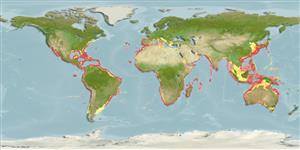Classification / Names
Common names from other countries
Main reference
Size / Weight / Age
Max length : 420 cm TL male/unsexed; (Ref. 5578); common length : 250 cm TL male/unsexed; (Ref. 26999); max. published weight: 346.5 kg (Ref. 4699); max. reported age: 40 years (Ref. 31395)
Length at first maturity
Lm 235.0, range 220 - 300 cm
Environment
Marine; brackish; reef-associated; oceanodromous (Ref. 51243); depth range 0 - 400 m (Ref. 244), usually 200 - 400 m
Climate / Range
Subtropical, preferred 26°C (Ref. 107945); 45°N - 46°S, 120°W - 156°E (Ref. 55186)
Distribution
Western Atlantic: southern Massachusetts to Florida (USA), Georges Bank, Bahamas, Cuba, northern Gulf of Mexico, Nicaragua, southern Brazil and Uruguay (Ref. 58839). Eastern Atlantic: Canary Islands, Cape Verde, Senegal, Sierra Leone. Some records from the Mediterranean and Madeira may be based on Carcharhinus galapagensis. Indo-West Pacific: Red Sea (Ref. 5485), Mozambique and South Africa to Japan, China, Viet Nam and Australia. Eastern Pacific: southern California, USA to Gulf of California and the Revillagigedo Island. Highly migratory species, Annex I of the 1982 Convention on the Law of the Sea (Ref. 26139).
Countries | FAO areas | Ecosystems | Occurrences | Introductions
Short description
Dorsal
spines
(total): 0;
Dorsal
soft rays
(total): 0;
Anal
spines: 0;
Anal
soft rays: 0. A large shark with a broadly rounded snout, triangular saw-edged upper teeth, curved moderate-sized pectoral fins, and an interdorsal ridge (Ref. 5578). Blue-grey, lead-grey above, white below; tips of pectoral and pelvic fins, as well as lower lobe of caudal fin and dorsal fins often dusky in young, plain in adults (Ref. 9997).
IUCN Red List Status (Ref. 115185)
Threat to humans
Traumatogenic (Ref. 4690)
Human uses
Fisheries: commercial; gamefish: yes
Tools
Special reports
Download XML
Internet sources
Estimates of some properties based on models
Phylogenetic diversity index
PD50 = 0.5000 many relatives (e.g. carps) 0.5 - 2.0 few relatives (e.g. lungfishes)
Trophic Level
4.3 ±0.2 se; Based on diet studies.
Resilience
Very Low, minimum population doubling time more than 14 years (rm=0.02; also Musick et al. 2000 (Ref. 36717))
Vulnerability
Very high vulnerability (88 of 100)
Price category
